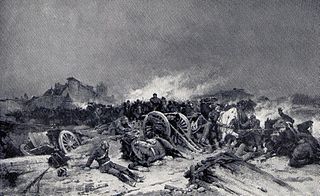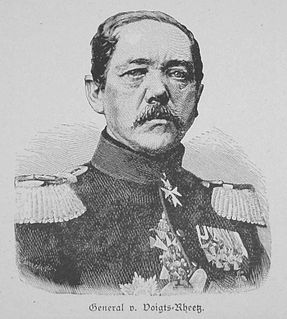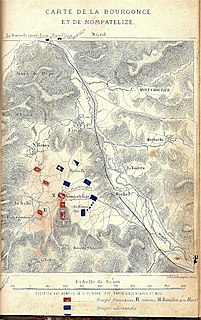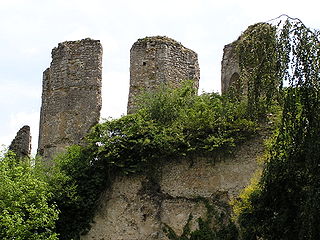
The Franco-Prussian War or Franco-German War, often referred to in France as the War of 1870, was a conflict between the Second French Empire and the North German Confederation led by the Kingdom of Prussia. Lasting from 19 July 1870 to 28 January 1871, the conflict was caused primarily by France's determination to restore its dominant position in continental Europe, which it had lost following Prussia's crushing victory over Austria in 1866. According to some historians, Prussian chancellor Otto von Bismarck deliberately provoked the French into declaring war on Prussia in order to draw four independent southern German states—Baden, Württemberg, Bavaria and Hesse-Darmstadt—to join the North German Confederation; other historians contend that Bismarck exploited the circumstances as they unfolded. None, however, dispute that Bismarck likely recognized the potential for new German alliances, given the situation as a whole.

The Battle of Mars-La-Tour was fought on 16 August 1870, during the Franco-Prussian War, near the village of Mars-La-Tour in northeast France. One Prussian corps, reinforced by two more later in the day, encountered the entire French Army of the Rhine in a meeting engagement and, surprisingly, forced the Army of the Rhine to retreat toward the fortress of Metz.

The Battle of Beaune-la-Rolande on 28 November 1870 was a battle of the Franco-Prussian War, won by Prussia. In an attempt to relieve the Siege of Paris, French General Crouzat's XX Corps launched an attack against three Prussian brigades resting in Beaune-la-Rolande. These brigades were from the Prussian X Corps which was detailed to guard the flanks and rear of the force besieging Paris and provide early warning of any French counter-attacks. The French committed a force of 60,000 men, largely conscripts of the Garde Mobile, and 140 guns against the Prussians' 9,000 men and 70 guns, mostly drawn from regular troops. Despite the overwhelming superiority of numbers the French attack failed to take the village and was ultimately forced to retreat by Prussian reinforcements.

Konstantin Bernhard von Voigts-Rhetz was a Prussian general who served in the Austro-Prussian War and the Franco-Prussian War.
The Battle of Châtillon, also known as the Battle of Châtillon-sous-Bagneux, was a skirmish in the Siege of Paris between France and North German Confederation in the Franco-Prussian War, took place on October 13, 1870. This is also considered the first battle in the history of the French Third Republic. In this fierce battle – occurred at Châtillon and Sceaux, Corps V of the Prussian army under the command of Lieutenant General Infantry Hugo von Kirchbach, along with the II Corps of the Kingdom of Bavaria by the Supreme Minister infantry Jakob von Hartmann which were the forces of the army Group 3 of Prussia by Prince Friedrich Wilhelm as General command., won a victory against an attack by the XIV Corps under General Renault - of the French army under General Auguste-Alexandre Ducrot. Although some soldiers under Ducrot fought well, the majority of his army became agitated. The French were forced to flee to Paris, losing the Châtillon Plateau - a very favorable defensive position overlooking the fortresses south of Paris - to the Germans. This was a disaster for the "justice" of the French army during the war, although the French reported that they suffered only minor losses.
The Siege of Marsal was a battle of the Franco-Prussian War on August 13 to 14 between the French Empire and the combined German forces of Prussia and Bavaria in Marsal Under the command of Lieutenant General Jakob von Hartmann, after replacing the Prussian 4th Cavalry Division, II Corps of the Kingdom of Bavaria forced the surrender of the French Empire's defenses, after a brief resistance by the French troops stationed at the fortress. Marsal fell to the German army in the same period as the French fortresses of Lichtenberg, La Petite-Pierre and Vitry. With the quick victory of the Bavarian army at Marsal, the road from Dieuze to Nancy was open to the Germans. In addition, the siege also brought the Germans a lot of raw materials for the war, as well as hundreds of prisoners.

The Battle of Nompatelize, also known as the Battle of Etival, was a battle of the Franco-Prussian War on October 6, 1870, between Etival and Nompatelize in the province of Vosges from Strasbourg 64 km southwest. This battle marked the first major crackdown of franc-tireur operations in the Vosges region by the XIV Corps of the Prussians by Minister August von Werder in early October 1870. In matches fiercely this, A force of the Army of Rhône of the French Republic under the command of General Louis-François Dupré, who predominated to markedly document in terms of troop numbers, and attacked 6 infantry batallions of the Grand Duchy of Baden under the command of General Alfred von Degenfeld which were part of the XIV Corps, but were defeated. Compared to the casualties of the German military, the losses of the French side in this battle were much greater. After seven hours of fighting, the French were forced to flee in turmoil to Bruyeres and the Rambervillers. The Battle of Etival contributed to General Werder wiping out the French from Alsace.
The Siege of La Fère took place during the Franco-Prussian War from November 15 until November 26, 1870, at the fortress of La Fère in France. French troops stationed at La Fère under the command of Captain Jacques Ferdinand Planche resisted the siege from the Imperial German Army, but surrendered the fort after eleven days on November 26, 1870, which resulted in a German victory. During the siege, the German army captured thousands of prisoners, most of whom were Garde Mobile soldiers, and took control of many French weapons. The German shelling of La Fère took place over the course of two days and severely damaged the town. After the Germans captured La Fère, they used cannons to arm the stronghold of Amiens.
The Siege of Sélestat was a siege in France, taking place from 20 to 24 October 1870, during the Franco-Prussian War. After a heavy artillery bombardment by the Germans, the siege ended with the French army at Sélestat surrendering to the German army, mainly because the French garrison was demoralized. While they suffered only minor losses, this victory brought the Germans many spoils.
The Battle of Ognon was a battle in the Franco-Prussian War, which took place on October 22, 1870, at the Ognon River. In this battle the Prussian XIV Corps under the command of General Karl August von Werder, which also consisted of a division of the Grand Duchy of Baden, attacked elements of the French Army of the Rhine commanded by General Albert Cambriels. The Germans captured a large number of French prisoners. The German victory in the Battle of Ognon decided the fate of the Army of the Rhine, at least within two weeks thereafter.
The Battle of Chateauneuf-en-Thimerais was a battle of the Franco-Prussian War, which took place on November 18, 1870, in the commune of Châteauneuf-en-Thymerais in France. This was one of a series of victories by a division of the Prussian army along the Loire under the command of Frederick Francis II, Grand Duke of Mecklenburg-Schwerin before the Garde Mobile's forces fledgling by commander Minister Fiereck, within a week after the Imperial German Army was defeated at the Battle of Coulmiers. During the Battle of Châteauneuf-en-Thimerais, the 22nd Division of the Kingdom of Prussia – noted as a brave division – was under the command of General Friedrich Wilhelm Ludwig von Wittich who captured the commune, taking in his hands hundreds of French prisoners of war. The failure at this battle forced the French forces to retreat westward.

The Battle of Artenay' also known as the Battle of Arthenay, is a battle in the Franco-Prussian War, was held on October 10, 1870, in Artenay a small town located on the road from Orléans to Paris, France which was about 10 miles north of the city of Orléans. In this fierce battle, with superior strength compared to the opponent, The I Corps of the Kingdom of Bavaria, under the command of Lieutenant General Ludwig von der Tann-Rathsamhausen, in collaboration with the 22nd Division of the XI Corps of the Kingdom of Prussia and the two cavalry divisions of the Prussian army attacked and penetrated the defense system of the army of the Loire of the young French Republic, under the control of general Joseph Edouard de la Motterouge, causing heavy losses for the French military of which many people were taken prisoner. The winning conditions Artenay were favorable enough for Von der Tann to stike Orléans, while the forces of France knocked back on Orléans forest in an agitated state. Despite this, Nièvre's Garde Mobiles and the Pontifical Legion in the French army were noted for their strong resistance, while a monk in Prussian Cavalry under the command of Prince Albrecht demonstrated his prowess in the battle at Artenay.
The Battle of Ladon and Mézières was a battle fought at Ladon and Mézières-en-Gâtinais between the French Army of the Loire led by Louis d'Aurelle de Paladines and Imperial German Army led by Prince Friedrich Karl of Prussia on November 17, 1870. During the battle the Prussians forced the French forces to retreat into the Bellegarde woods. Although the French army was quickly defeated in this battle, it showed the Prussians the substantial size of the French XX corps. the engagement showed the Germans that substantial forces of the French XX Corps were present on the battlefield. The defeat caused great damage to French morale. On November 17 the French attacked the Prussians again at the Battle of Beaune-la-Rolande, but they were defeated again.

The Battle of Varize was a battle in the Franco-Prussian War, that happened on November 29, 1870, in Varize, on the river Conie. In this battle, the First Bavarian Corps under the command of Lieutenant General Infantry Ludwig von der Tann attacked a guerrilla army franc-tireurs of the French Republic under the command of Colonel Ernest de Lipowski, and made them scatter. Despite this, the defense at Varize enabled General Antoine Chanzy, commander of the French Army of Loire, to establish a defensive formation against the Prussian army under the direction of Friedrich Franz II, Grand Duke of Mecklenburg-Schwerin. With their victory at the Battle of Varize, Bavarian forces captured a number of well-equipped French guerrillas.
The Battle of Châteauneuf was a battle in the Franco-Prussian War that took place on December 3, 1870, at the Châteauneuf-sur-Loire, Loire, France. During this engagement, the 3rd Infantry Brigade of the Prussian army, which was a part of the Baden Division and was under the command of General Keller repelled an ambush of the French army under the command of General Camille Crémer. The battle facilitated the Prussian army to continue its withdrawal from Autun. The battle lasted for seven hours, and brought the Prussian army negligible losses, with 153 casualties. However, the Germans viewed this engagement as one of their most glorious victories of the campaign.
The Battle of Buchy was a battle during the Franco-Prussian War, fought on December 4, 1870, at Buchy, Seine-Maritime, France. During the battle, the VIII Corps of the Prussian Army, under the command of General of the Infantry August Karl von Goeben, suddenly attacked and defeated a force in the French army under the command of General de Brigade Guillaume Briand. This defeat inflicted heavy losses on the French forces, and thousands of French soldiers were taken prisoner. After the victory at Buchy, German troops captured Rouen.
The Fighting in Fréteval was a battle in the Franco-Prussian War, it occurred in December 14 — 15, 1870, near the village of Fréteval of France. In this fierce engagement, a corps of the Prussian army under the command of Friedrich Franz II, Grand Duke of Mecklenburg-Schwerin contested Fréteval with a force of the French army 's Loire Corps under General Antoine Chanzy, but neither side was able to seize the advantage. The battle demonstrated the effective combat capabilities of Chanzy's forces, with a huge numerical superiority over Mecklenburg's forces. From the 15th of December, however, Mecklenburg's army was reinforced on the left, and in light of that situation Chanzy finally made a retreat to Le Mans.

The Battle of Vendôme was a battle of the Franco-Prussian War, it lasted from December 14 — 17, 1870 in Vendôme, Loir-et-Cher, France. In this fierce fighting, the X Army of the Kingdom of Prussia under the command of General Konstantin Bernhard von Voigts-Rhetz and the 2nd Army of Prussia which was commanded by Prince Friedrich Karl, attacked the French Army of the Loire by Minister Antoine Chanzy and Admiral Bernard Jaureguiberry who was a former navy officer of France. The Prussians defeated the French in a gun battle on December 16 and finally won the battle. With this victory, the Germans attacked the enemy's right flank and forced the French forces to withdraw from their stronger defensive position at Fréteval, where they engaged another Prussian army indecisively. The victory at Vendôme also brought the Prussian armies some French prisoners and weapons, while the disadvantage of Chanzy's army forced him to hastily withdraw to Le Mans.

The Siege of Rocroi was a battle of the Franco-Prussian War, it was held in January 4 to the 6th, 1871 at Rocroi which was a bastion of France located to the west of Sedan. After an artillery fire by the Prussian army, the officer commanding the French troops at Rocroi was forced to surrender the Division Militia under General Schuler and Sendan and Wilhelm von Woyna. With the success of the Siege of Rocroi, the military spectrum was obtained on their hands were hundreds of prisoners along with many stocks, costumes and contemporary heavyweight artillery of the French. During this siege, the town of Rocroi was heavily destroyed. The fall of Rocroi marked one of the German army's consecutive victories in the war.

The Battle of Pontarlier, also known as the Battle of Pontarlier-La Cluse, was the final military operation of the Franco-Prussian War, that took place from January 29 to February 2, 1871, near Pontarlier and La Cluse-et-Mijoux, not long after the newly formed German Empire and French Republic had a ceasefire. During these engagements, the German Army of the South, under the command of Lieutenant General Edwin von Manteuffel won over the French Eastern Army under the command of General Justin Clinchant, the battle forced the French Eastern Army to withdraw to neutral Switzerland. The strong efforts of the German armies led by General August von Werder in The previous Battle of the Lisaine, as well as that of General Von Manteuffel's armies at the Battle of Pontarlier, resulted in the collapse of the assault on southern Germany which the Eastern Army had expected to be ruined. At the same time, the defeat of the Eastern Army finally forced the French Interior Minister Léon Gambetta to end resistance to the Germans. The defeat at Pontarlier also brought the French heavy losses, including a large number of soldiers being taken prisoner.









